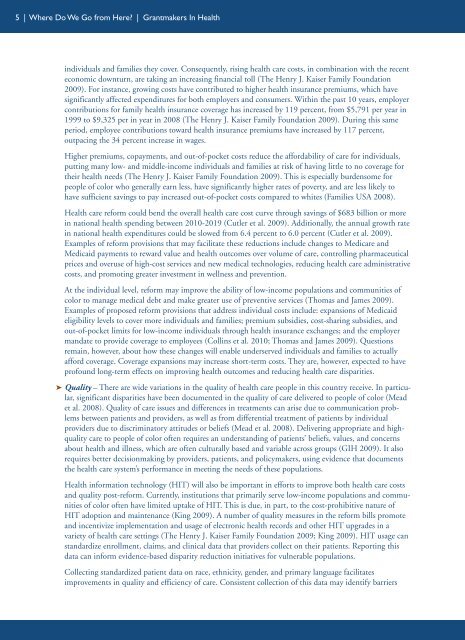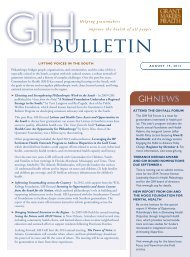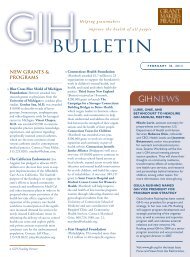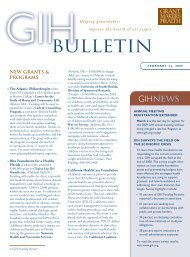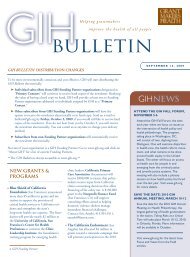Where Do We Go from Here? Combating Health Care Disparities in ...
Where Do We Go from Here? Combating Health Care Disparities in ...
Where Do We Go from Here? Combating Health Care Disparities in ...
Create successful ePaper yourself
Turn your PDF publications into a flip-book with our unique Google optimized e-Paper software.
5 | <strong>Where</strong> <strong>Do</strong> <strong>We</strong> <strong>Go</strong> <strong>from</strong> <strong>Here</strong>? | Grantmakers In <strong>Health</strong><br />
<strong>in</strong>dividuals and families they cover. Consequently, ris<strong>in</strong>g health care costs, <strong>in</strong> comb<strong>in</strong>ation with the recent<br />
economic downturn, are tak<strong>in</strong>g an <strong>in</strong>creas<strong>in</strong>g f<strong>in</strong>ancial toll (The Henry J. Kaiser Family Foundation<br />
2009). For <strong>in</strong>stance, grow<strong>in</strong>g costs have contributed to higher health <strong>in</strong>surance premiums, which have<br />
significantly affected expenditures for both employers and consumers. With<strong>in</strong> the past 10 years, employer<br />
contributions for family health <strong>in</strong>surance coverage has <strong>in</strong>creased by 119 percent, <strong>from</strong> $5,791 per year <strong>in</strong><br />
1999 to $9,325 per <strong>in</strong> year <strong>in</strong> 2008 (The Henry J. Kaiser Family Foundation 2009). Dur<strong>in</strong>g this same<br />
period, employee contributions toward health <strong>in</strong>surance premiums have <strong>in</strong>creased by 117 percent,<br />
outpac<strong>in</strong>g the 34 percent <strong>in</strong>crease <strong>in</strong> wages.<br />
Higher premiums, copayments, and out-of-pocket costs reduce the affordability of care for <strong>in</strong>dividuals,<br />
putt<strong>in</strong>g many low- and middle-<strong>in</strong>come <strong>in</strong>dividuals and families at risk of hav<strong>in</strong>g little to no coverage for<br />
their health needs (The Henry J. Kaiser Family Foundation 2009). This is especially burdensome for<br />
people of color who generally earn less, have significantly higher rates of poverty, and are less likely to<br />
have sufficient sav<strong>in</strong>gs to pay <strong>in</strong>creased out-of-pocket costs compared to whites (Families USA 2008).<br />
<strong>Health</strong> care reform could bend the overall health care cost curve through sav<strong>in</strong>gs of $683 billion or more<br />
<strong>in</strong> national health spend<strong>in</strong>g between 2010-2019 (Cutler et al. 2009). Additionally, the annual growth rate<br />
<strong>in</strong> national health expenditures could be slowed <strong>from</strong> 6.4 percent to 6.0 percent (Cutler et al. 2009).<br />
Examples of reform provisions that may facilitate these reductions <strong>in</strong>clude changes to Medicare and<br />
Medicaid payments to reward value and health outcomes over volume of care, controll<strong>in</strong>g pharmaceutical<br />
prices and overuse of high-cost services and new medical technologies, reduc<strong>in</strong>g health care adm<strong>in</strong>istrative<br />
costs, and promot<strong>in</strong>g greater <strong>in</strong>vestment <strong>in</strong> wellness and prevention.<br />
At the <strong>in</strong>dividual level, reform may improve the ability of low-<strong>in</strong>come populations and communities of<br />
color to manage medical debt and make greater use of preventive services (Thomas and James 2009).<br />
Examples of proposed reform provisions that address <strong>in</strong>dividual costs <strong>in</strong>clude: expansions of Medicaid<br />
eligibility levels to cover more <strong>in</strong>dividuals and families; premium subsidies, cost-shar<strong>in</strong>g subsidies, and<br />
out-of-pocket limits for low-<strong>in</strong>come <strong>in</strong>dividuals through health <strong>in</strong>surance exchanges; and the employer<br />
mandate to provide coverage to employees (Coll<strong>in</strong>s et al. 2010; Thomas and James 2009). Questions<br />
rema<strong>in</strong>, however, about how these changes will enable underserved <strong>in</strong>dividuals and families to actually<br />
afford coverage. Coverage expansions may <strong>in</strong>crease short-term costs. They are, however, expected to have<br />
profound long-term effects on improv<strong>in</strong>g health outcomes and reduc<strong>in</strong>g health care disparities.<br />
➤ Quality – There are wide variations <strong>in</strong> the quality of health care people <strong>in</strong> this country receive. In particular,<br />
significant disparities have been documented <strong>in</strong> the quality of care delivered to people of color (Mead<br />
et al. 2008). Quality of care issues and differences <strong>in</strong> treatments can arise due to communication problems<br />
between patients and providers, as well as <strong>from</strong> differential treatment of patients by <strong>in</strong>dividual<br />
providers due to discrim<strong>in</strong>atory attitudes or beliefs (Mead et al. 2008). Deliver<strong>in</strong>g appropriate and highquality<br />
care to people of color often requires an understand<strong>in</strong>g of patients’ beliefs, values, and concerns<br />
about health and illness, which are often culturally based and variable across groups (GIH 2009). It also<br />
requires better decisionmak<strong>in</strong>g by providers, patients, and policymakers, us<strong>in</strong>g evidence that documents<br />
the health care system’s performance <strong>in</strong> meet<strong>in</strong>g the needs of these populations.<br />
<strong>Health</strong> <strong>in</strong>formation technology (HIT) will also be important <strong>in</strong> efforts to improve both health care costs<br />
and quality post-reform. Currently, <strong>in</strong>stitutions that primarily serve low-<strong>in</strong>come populations and communities<br />
of color often have limited uptake of HIT. This is due, <strong>in</strong> part, to the cost-prohibitive nature of<br />
HIT adoption and ma<strong>in</strong>tenance (K<strong>in</strong>g 2009). A number of quality measures <strong>in</strong> the reform bills promote<br />
and <strong>in</strong>centivize implementation and usage of electronic health records and other HIT upgrades <strong>in</strong> a<br />
variety of health care sett<strong>in</strong>gs (The Henry J. Kaiser Family Foundation 2009; K<strong>in</strong>g 2009). HIT usage can<br />
standardize enrollment, claims, and cl<strong>in</strong>ical data that providers collect on their patients. Report<strong>in</strong>g this<br />
data can <strong>in</strong>form evidence-based disparity reduction <strong>in</strong>itiatives for vulnerable populations.<br />
Collect<strong>in</strong>g standardized patient data on race, ethnicity, gender, and primary language facilitates<br />
improvements <strong>in</strong> quality and efficiency of care. Consistent collection of this data may identify barriers


